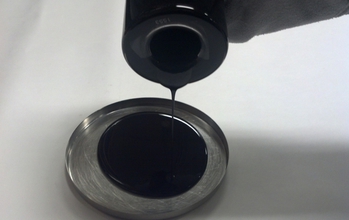Discovery
Old tires become material for new and improved roads
“Crumb” rubber can lower road noise and reduce need for road maintenance
|
Asphalt rubber binders can be used as traditional binders with no particle-related concerns. |
April 21, 2014
Americans generate nearly 300 million scrap tires every year, according to the Environmental Protection Agency (EPA). Historically, these worn tires often end up in landfills or, when illegally dumped, become breeding grounds for disease-carrying mosquitoes and rodents. They also pose a potential fire hazard.
In recent years, however, interest has been growing in finding new, beneficial and environmentally friendly uses for discarded tires.
Magdy Abdelrahman, for example, an associate professor of civil and environmental engineering at North Dakota State University, is working on ways to turn old tires into new and improved roads.
The National Science Foundation (NSF)-funded scientist is experimenting with “crumb” rubber–ground up tires of different sized particles–and other components to improve the rubberized road materials that a number of states already are using to enhance aging asphalt.
“It’s very durable,” he says. “We mix it with different materials and in different percentages, and in different conditions, to find the best ways to add rubber to asphalt.”
Asphalt rubber is the largest single market for ground rubber, consuming an estimated 220 million pounds, or approximately 12 million tires, according to the EPA. California and Arizona use the most asphalt rubber in highway construction, followed by Florida, the EPA says. Other states that are using asphalt rubber, or are studying its potential, include Texas, Nebraska, South Carolina, New York and New Mexico, according to the agency.
Ground tire rubber, when blended with asphalt, produces longer lasting road surfaces, and can lower road noise and the need for road maintenance.
Moreover, “this project will have a broad impact because solid waste is problematic throughout the world,” Abelrahman says. “Asphalt applications have the potential to contribute to the solution of the growing solid waste problem provided that engineering and environmental concerns are addressed. Asphalt binders represent an area that can improve pavement performance.”
Abdelrahman’s research involves studying interactions of crumb rubber with specific additives to evaluate and characterize the physical and chemical properties of the compounds. He also is trying to determine whether certain conditions, such as bad weather, will cause chemical releases from the recycled materials–from polymers, for example–and the potential impact on soil and groundwater.
“We want to assess the environmental impact of adding components to the mixing of crumb rubber and asphalt, for example, is it going to leach out in the rain?” he says. “Traditional, that is, normal, asphalt-rubber materials will not cause harm to the soil or the ground water. But some additives may.
“We already know that the technology [rubberized roads] is proven to work, but we want to make it work much, much better,” he adds. “We are trying to find the scientific and engineering aspects to make it better and, at the same time, be sure it is environmentally friendly.”
Abdelrahman is conducting his work with an NSF Faculty Early Career Development (CAREER) award, which he received in 2009. The award supports junior faculty who exemplify the role of teacher-scholars through outstanding research, excellent education, and the integration of education and research within the context of the mission of their organization. NSF is funding his work with about $400,000 over five years.
The grant’s educational component is strongly tied to the research, through developing a graduate/senior course on recycled material applications with significant scientific components, and through faculty-professional focus meetings to exchange experiences in the area of recycled materials.
He also plans to develop activities to recruit, train, and mentor students in the undergraduate and graduate programs, with the goal of preparing them for careers in recycled materials.
“We want to get the undergraduates involved in research activities and show them the technology we have developed,” he says.
Furthermore, community outreach activities “will raise the awareness of K-12 students to the environmental issues facing the local as well as the global community regarding solid waste management,” he says. “We will hold classes, seminars, even with kids in elementary school and show them: let’s recycle some material.
“It is really important for them to understand that if we keep using new materials, that our grandchildren won’t have anything left,” he adds. “We’re trying to get them to think about what will be available to the next generation in the way of resources if we cannot, or do not, use recycled materials. The goal is to educate high school, middle school and elementary school children, and show them that this is what needs to be done.”
| — | Marlene Cimons, National Science Foundation |
Investigators
Magdy Abdelrahman
Related Institutions/Organizations
North Dakota State University Fargo
Total Grants
$400,000
![]()
